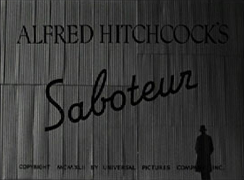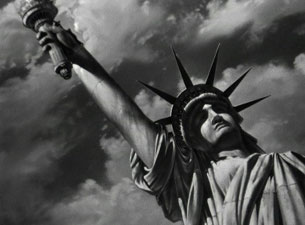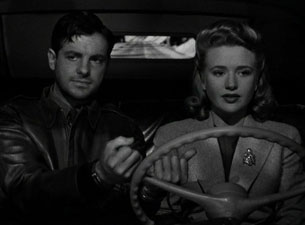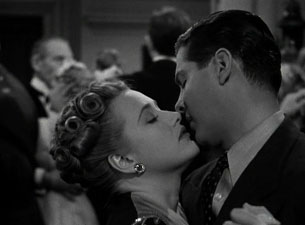

|
| –  zur Startseite der Filmchronik |
BEMERKENSWERTE FILME AUS DEM JAHRE 1942 Saboteur |
|
|
|
||
|
Während des Zweiten Weltkrieges wird eine amerikanische Flugzeugfabrik zerstört. Der dort beschäftigte Barry Kane wird fälschlicherweis der Sabotage beschuldigt. Um seine Unschuld zu beweisen, verfolgt er den mysteriösen Mr. Fry, den er für den wahren Täter hält. Die Jagd quer durch die USA endet mit einem Showdown in New York auf der Spitze der Freiheitsstatue. In seinem Klassiker variiert Alfred Hitchcock einmal mehr das Thema des unschuldig Verdächtigten, der sich in einer scheinbar ausweglosen Lage befindet. In gewisser Hinsicht ist der Film ein Remake des in England gedrehten Films The Thirty-nine Steps an amerikanische Schauplätzen. |
| Darsteller | Besprechung (englisch) |
|
|
| Company: Metro-Goldwyn-Mayer Regisseur: Alfred Hitchcock Produzenten: Frank Lloyd, Jack H. Skirball Drehbuch: Joan Harrison, Alfred Hitchcock, Dorothy Parker, Peter Viertel Musik: Charles Prévin, Frank Sinner Kamera: Joseph A. Valentine Herkunftsland: USA Genre: Thriller Schwarz-Weiss Laufzeit: 105 Minuten |
 
|
|
|
| Darsteller: |
Rollen: |
|
| Priscilla Lane | Patricia Martin, called Pat | |
| Robert Cummings | Barry Kane | |
| Norman Lloyd | Frank Fry | |
| Otto Kruger | Charles Tobin | |
| Murray Alper | Truck Driver | |
| Vaughan Glaser | Phillip Martin | |
| Alma Kruger | Mrs. Henrietta Van Sutton | |
| Dorothy Peterson | Mrs. Mason | |
| Kathryn Adams | Young Mother | |
| Alan Baxter | Mr. Freeman | |
| Clem Bevans | Neilson | |
| Oliver Blake | Man | |
| Anita Bolster | Esmeralda the Bearded Lady/Lorelei | |
| Billy Curtis | Major the Midget | |
| Norma Drury | Refugee Mother | |
| William Gould | Stranger | |
| Gene Garrick | Worker | |
| Jack Gardner | Pat’s Taxi Driver | |
| Eddie Foster | Driver for Saboteurs | |
| James Flavin | ||
| Pat Flaherty | Navy Man | |
| Paul Everton | Bus Man | |
| John Eldredge | Footman | |
| Ralph Dunn | FBI Man at Mason’s House | |
| Gene O’Donnell | Jitterbug | |
| Margaret Moffat | Neighbor | |
| Belle Mitchell | Adele, the Maid | |
| Walter Miller | ||
| Kermit Maynard | Cowhand | |
| Frank Marlowe | George, the Truck Driver | |
| Lou Lubin | ||
| Alexander Lockwood | Marine | |
| Will Lee | Worker | |
| Marjorie Wood | Farmer’s Wife | |
| Ian Wolfe | Robert the Butler | |
| Matt Willis | Deputy | |
| Claire Whitney | Wife in Movie Audience | |
| Dale Van Sickel | FBI Assistant/Phone Operator | |
| Archie Twitchell | Motorcycle Cop | |
| Jean Trent | Blonde Aircraft Worker | |
| Torin Thatcher | ||
| Harry Strang | Cop | |
| Don Cadell | FBI Man | |
| Gerald Pierce | Elevator Operator | |
| Jimmie Lucas | Taxi Driver | |
| Claire James | Deaf Man’s Companion | |
| Ted Offenbecker | Worker | |
| Alfred Hitchcock | Deaf Man Outside Drug Store | |
| Duke York | Deputy | |
| Barton Yarborough | 1st FBI Man at Mason’s House | |
| Will Wright | Company Official | |
| Charles Sherlock | Barry’s Taxi Driver | |
| Jeffrey Sayre | Henchman | |
| William H. Ruhl | Deputy Marshal | |
| Jeanne Romer | Marigold, Siamese Twin | |
| Cyril Ring | Party Guest | |
| Paul Phillips | Driver | |
| Lee Phelps | Plant Policeman | |
| Emory Parnell | Husband in Movie | |
| Rex Lease | Plant Counterman | |
| Marie Le Deaux | Tatiana the Fat Woman | |
| Milt Kibbee | Husband in Movie Audience | |
| Selmar Jackson | FBI Chief | |
| Samuel S. Hinds | Foundation Leader | |
| Maggie Hayes | Wife in Movie | |
| Vinton Haworth | Other Man in Movie | |
| Charles Halton | Sheriff | |
| Pedro de Cordoba | Bones the Human Skeleton | |
| Al Bridge | Marine Sergeant MP | |
| Paul E. Burns | Farmer | |
| Frances Carson | Society Woman | |
| Jack Cheatham | Detective | |
| Hans Conried | Edward | |
| Kernan Cripps | Man in Movie Audience |
|
|
|
Robert Cummings is a very competent hero. In some scenes in this film, he comes close to the nonchalance that James Stewart brought to many Hitchcock works. Of course a problem for modern viewers may be this nonchalance. Because the era that bred Saboteur featured low-key performances, modern audiences may succumb to the ever-present boredom caused by anything without a frenetic pace or overwrought acting. Cummings does not play Barry Kane with an emotional bent fashioned by some method-acting ranter; rather, he skips from problem to problem with typical mid-century stoicism. What needs to be done will be done, one can imagine Cummings saying in an interview. The premise of the film surfaces in many Hitchcock films. An innocent man – Barry Kane – is accused of setting a fire to a factory that produces aircraft for the American war effort. What’s worse, he’s thought to have handed his best buddy an extinguisher filled with gasoline. The buddy perishes. What’s the rub? A mysterious character named Fry (Norman Lloyd) is the actual saboteur, but only Kane and his dead friend had contact with this nasty, fox-like man. Soon Kane is on the lam from the law. As in The Fugitive, Kane compounds his legal troubles by escaping: he must be so thoroughly convinced that he will take the rap for this heinous crime of sabotage, treason and murder, that he determines to set off on his own to find Fry and anyone backing him. |
 |
| On the way, Kane finds refuge in the house of a blind man, who cannot see Kane’s handcuffs but somehow senses everything. This man’s niece soon enters, and though her uncle instructs her to accompany Kane to a locksmith’s to remove the cuffs, she (Priscilla Lane as Patricia Martin). Kane adds kidnapping to his legion of infractions, apparently trusting that everything will turn out in the end. (Of course, part of Hitchcock’s genius was in getting everything to turn out satisfactorily for his audiences; he certainly knew what viewers of his time demanded.) More complications ensue, and we spot countless Hitchcockian trademarks – wealthy and respected criminal masterminds, ingenues in jeopardy, American icons used to support suspenseful plot twists. I think part of the contrived feeling of the plot is the artifice used to set up some of the climactic situations. Exactly why would a saboteur tour the Statue of Liberty after he has damaged an American warship as it launched? Would anyone but a 40’s film heroine endanger herself by trying to delay or trap this ruthless criminal, and would anyone but the hero try to save this selfsame criminal as he hangs from the hand of Lady Liberty? These people are apparently moral to the core. A minor and interesting agenda involves a further boost to the common man: a truck driver who gives Kane a ride early in his flight from justice surfaces later to assist him in escaping from the very clutches of the cops. It’s almost as if Hitchcock is cheering the proletariat, while the monied ne’er-do-wells scheme and plot for the downfall of the war effort, and perhaps even control of the country. (There are definite undercurrents here that attack fascism.) |
 |
|
Nevertheless, we see some stunning camera work and memorable images. Everything Hitchcock touched was in some way artificial, from the California mountains to the massive statue at the end – painted backdrops within studios, or smaller-than-life models. But the use this director makes of his props is amazing. Perhaps the pace of the film could be tighter in scenes, but every scene does seem necessary. There is even some top-notch comic relief – coming mostly when Kane and Martin are saved from a police search by a caravan full of circus performers. Pricilla Lane does a very smooth job as Patricia Martin, the headstrong niece of an eminently decent blind man. A pity she did not get more roles: her acting talents might have made her a household name. For fans of Hitchcock, Saboteur is a must-see. It clearly foreshadows his later successes with big names like Cary Grant and James Stewart and Doris Day. And the changes of scenery show that he was a filmmaker on the move, unafraid to use location shots mixed with rear projection and studio fakeries. |
|
zum Seitenkopf |